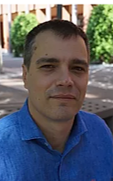 Organization/Department
Organization/Department
Associate Professor
Department of Bioengineering and Aerospace Engineering
University Carlos III of Madrid
Biography
Diego Velasco Bayón obtained his BSc in chemistry in 2005 (University of Córdoba, Spain) and has been hired shortly after as a junior researcher with a contract associated to a European project in the Institute of Polymer Science and Technology (ICTP-CSIC, Madrid, Spain). At the Institute of Polymer Science and Technology, he carried out a European doctoral thesis with focus on polymerization methods, preparation and biological characterization of polymeric biomaterials with applications in pharmacology and tissue engineering. After spending one year in the National University of Ireland, two years (2011-2013) as a postdoctoral fellow hired from NSREC at Prof. Eugenia Kumacheva’s laboratory and one year (2013-2014) as an application developer for the FlowJEM Polymer Microfluidic Technology Company, he eventually joined the UC3M as an assistant professor at the Department of Bioengineering and Aerospace Engineering. He later became visiting professor and is now associate professor at the same department teaching and coordinating courses such as “Introduction to Biomaterials” and “Biomaterials Experimental Design”. He was also the Deputy Director (2017-2020) and recently the Director of the Master in Biomedical Technologies Management and Development (UC3M) and coordinator and teacher of one of the courses “Innovation in the pharmaceutical industry: Advanced Medicines and Biotechnology”.
His research interest is focused on skin engineering, in particular, the optimization of preclinical 3D cultured skin substitutes, improving the mechanical and biological properties of the dermal compartment with natural and synthetic biomaterials. Generation of more complex skin equivalents with appendages such as hair follicles in the skin equivalents. Design of new bioinks for the regeneration of human skin for their use in extrusion based bioprinting technology as well as the design of new chips using microfabrication technology and microfluidics for the modelling of the skin and its diseases.
He is a member of the Scientific and Organisational Committee, scientific co-chair of several conferences/workshops, to highlight: XLI Congreso de la Sociedad Ibérica de Biomecánica y Biomateriales (Madrid, 2018), Tissue Engineering and Regenerative Medicine International Society-EU 2010 (TERMIS, Galway, 2010). 25th European Conference on Biomaterials (Madrid, 2013). In addition, he is an editor of the journal Biomecánica: Órgano de la Sociedad Ibérica de Biomecánica y Biomateriales (SIBB) and recently President and also a member of the Spanish Royal Society of Chemistry (RSEQ) and the European Society for Biomaterials (ESB). During his research he collaborated with Prof. Sergei G. Kazarian, Prof. A. Pandit, Prof. Eugenia Kumacheva’s laboratory, Lucy Votjová and many more.
Title of Talk
3D Bioprinting of Human Plasma-Based Bilayered Skin
Abstract
In the last decades, the demand of in vitro skin substitutes that mimic human skin has increased either for in vitro toxicology testing or for clinical use. In this way the development and production of in vitro-engineered skin substitutes has progressed towards more sophisticated cellular bilayered constructs based on collagen and fibrin containing dermal and epidermal components. This talk will describe the use of human plasma-derived fibrin hydrogels as a 3D scaffold in skin engineering that, unlike the use of animal renatured collagen or commercial fibrin, allows a fully autologous process for skin grafting and an efficient production of natural collagen by human fibroblasts In this sense, our group has engineered a human plasma-derived bilayered skin substitute containing primary human fibroblasts (hFBs) and keratinocytes (hKCs) from skin biopsies for different skin tissue engineering applications: 1) to treat burns and traumatic and surgical wounds in a large number of patients in Spain; 2) to generate skin-humanized mouse models; and 3) to develop a complete system to 3D print this bilayered skin for clinical and commercial testing purposes. It will be also discussed several issues associated with the use of fibrin-based hydrogels in skin engineering, thus leading to disadvantages in their reproducibility and applicability in vitro and in vivo.
